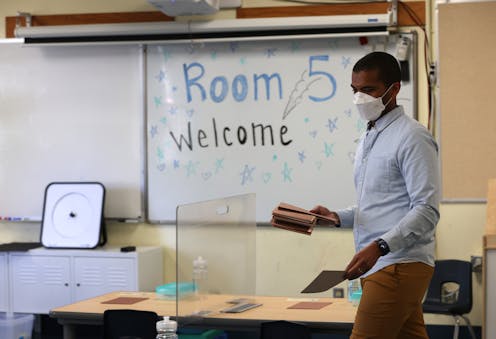4 ways to get more Black and Latino teachers in K-12 public schools
- Written by Travis Bristol, Assistant Professor of Education, University of California, Berkeley

Black children are more likely to score higher on standardized tests[1] and finish high school and want to attend college[2], and less likely to be suspended[3], if they have a Black teacher. Similarly, studies show that Latino students who have a Latino teacher are more likely to want to take advanced coursework[4].
This data reflects earlier research on Black and Latino teachers[5] and the positive social and emotional experiences they create for their students.
Education historian Vanessa Siddle Walker writes[6] about how, even before the Brown v. Board of Education[7] school desegregation decision in 1954, Black teachers and principals provided their students with tools and a framework to navigate a society that was anti-Black. And renowned education researcher Gloria Ladson-Billings explains[8] Black teachers’ capacity to draw on their own experiences as Black people in the U.S. and incorporate their Black students’ cultural experiences into the classroom.
Given the added value of teachers of color, a pressing problem remains: There is a considerable demographic mismatch between teachers and students of color in the U.S. While teachers of color represent 21% of public school educators[9], students of color account for more than 52% of public school students[10].
As an education researcher[11], I study the experiences of teachers of color. Here are four ways to get more teachers from ethnically and racially diverse backgrounds in K-12 classrooms.
1. Focus on retention
Policymakers, school principals and philanthropies have spent a great deal of resources on recruiting teachers of color[12]. And those efforts have paid off. More Black and Latino teachers[13] are entering the teacher workforce.
The story now is one of retention.
Teachers of color leave the profession and move to other schools at a higher rate[14] than their white peers. An analysis of nine school districts[15] found that Black teachers in particular have higher turnover rates than their white and Latino peers. For example, the number of Black teachers in Chicago Public Schools decreased by 39%[16] between 2002 and 2011, compared to a 3% decrease in white teachers and a 6% increase in Latino teachers during the same period.
2. Improve leadership, work conditions
Historically, researchers believed[17] that teachers in urban schools that predominantly serve children of color left their schools because they did not want to work with those students. But teachers don’t leave their students; teachers leave their principals.
Principals create the working conditions that lead to turnover[18] by not supporting teachers or providing the resources they need to work with their students.
To ensure that principals instead create conditions that help teachers of color thrive, they need high-quality preparation. This preparation should include a focus on how to support new teachers as well as work collegially with students, caregivers and teachers.
Model programs that continue to do this work are The Leadership Academy[19] and the Principal Leadership Institute[20] at University of California, Berkeley.
3. Fund schools equitably
To retain teachers of color, districts have to improve the working conditions in their schools. One way to do this is to fund schools more equitably.
Some states, like California[21], have a more progressive, equitable funding formula. That means schools that have a significant number of students who are unhoused, adopted, qualify for free or reduced lunch, or speak English as a second language get more money and resources.
Other states, like New York and Illinois[22], which are home to some of our country’s largest public school districts, have more regressive funding formulas. Since public schools are primarily funded by local property taxes, students who live in high-income communities across New York State, for example, attend more well-resourced schools[23] than children living in low-income communities. Legal efforts[24] to dismantle this separate and unequal funding system are ongoing.
4. Redesign teacher training
The U.S. has a wide variety of teacher preparation programs. There’s no common framework for thinking about how to prepare people to become teachers.
Furthermore, in states like California and Texas, after two months of preparation a new teacher can teach children in historically marginalized communities. Given where these teachers are placed, it is clear that school districts, like Oakland Public Schools, will hire those new educators[25].
Placing the most inexperienced teachers in schools with the most challenging working conditions increases turnover[26].
What stands in the way of getting more Black and Latino teachers in classrooms is not a clear understanding of the problem, but the courage to act on what we already know.
[Like what you’ve read? Want more? Sign up for The Conversation’s daily newsletter[27].]
References
- ^ score higher on standardized tests (rowman.com)
- ^ finish high school and want to attend college (doi.org)
- ^ be suspended (doi.org)
- ^ advanced coursework (doi.org)
- ^ and Latino teachers (doi.org)
- ^ Vanessa Siddle Walker writes (doi.org)
- ^ Brown v. Board of Education (www.history.com)
- ^ Gloria Ladson-Billings explains (www.wiley.com)
- ^ 21% of public school educators (nces.ed.gov)
- ^ 52% of public school students (nces.ed.gov)
- ^ education researcher (scholar.google.com)
- ^ recruiting teachers of color (woodrow.org)
- ^ More Black and Latino teachers (nces.ed.gov)
- ^ higher rate (learningpolicyinstitute.org)
- ^ analysis of nine school districts (www.aft.org)
- ^ decreased by 39% (www.shankerinstitute.org)
- ^ researchers believed (eric.ed.gov)
- ^ working conditions that lead to turnover (eric.ed.gov)
- ^ The Leadership Academy (www.leadershipacademy.org)
- ^ Principal Leadership Institute (gse.berkeley.edu)
- ^ like California (learningpolicyinstitute.org)
- ^ like New York and Illinois (www.usnews.com)
- ^ more well-resourced schools (newyork.edtrust.org)
- ^ Legal efforts (nyser.org)
- ^ will hire those new educators (www.teachforamerica.org)
- ^ increases turnover (www.jstor.org)
- ^ Sign up for The Conversation’s daily newsletter (theconversation.com)
Authors: Travis Bristol, Assistant Professor of Education, University of California, Berkeley

